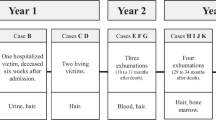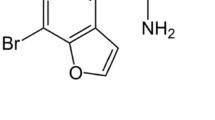Abstract
After the use of thallium as rat poison was banned, the knowledge about the severe and treacherous course of poisonings with this toxic metal has widely been lost. In the present case, the male victim sustained two insidious poisoning attacks in 2017 and 2020 by the perpetrator, his female life partner. In the first poisoning episode, he suffered from increasing heavy pain of the abdomen, stinging pain of both legs, persistent obstipation, hyperesthesia, and, after about 2 weeks, tuft-wise loss of hair as typical symptoms of the thallium poisoning. Within 7 weeks, he was successively examined in six hospitals with a wide variety of diagnostic methods, but a conclusive explanation of the complaints was not found. The possibility of a metal intoxication was then suggested by the perpetrator who privately arranged the analysis of a blood sample with the result of 175 µg/l thallium. Although a criminal poisoning was assumed, the perpetrator was not identified. After the victim left the perpetrator, she subtly executed a second poisoning attack with thallium sulfate (blood level 1230 µg/l after 1 day, urine level 4760 µg/l after 10 days, and hair concentrations 3.26–0.49 from proximal to distal in 9 segments). The perpetrator was sentenced to 10.5 years imprisonment for grievous bodily harm and attempted murder. Because of the behavior of the perpetrator, a Munchausen by proxy syndrome was discussed as a motivation of the first poisoning but was excluded by the psychiatric expert because of a missing antisocial personality disorder.



Similar content being viewed by others
Change history
09 March 2022
A Correction to this paper has been published: https://doi.org/10.1007/s00414-022-02811-3
References
Burton MC, Warren MB, Lapid MI, Bostwick JM (2015) Munchausen syndrome by adult proxy: a review of the literature. J Hosp Med 10(1):32–35
Yates G, Bass C (2017) The perpetrators of medical child abuse (Munchausen syndrome by proxy) - a systematic review of 796 cases. Child Abuse Negl 72:45–53
Moreno-Ariño M, Bayer A (2017) Munchausen syndrome by proxy-illness fabricated by another in older people. Age Ageing 46(2):166–167
Sigal MD, Altmark D, Carmel I (1986) Munchausen syndrome by adult proxy: a perpetrator abusing two adults. J Nerv Ment Dis 174(11):696–698
Sigal M, Altmark D, Gelkopf M (1991) Munchausen syndrome by adult proxy revisited. Isr J Psychiatry Relat Sci 28(1):33–36
Smith NJ, Ardern MH (1989) More in sickness than in health: a case study of Munchausen by proxy in the elderly. J Fam Ther 11(4):321–334
Krebs MO, Bouden A, Lôo H, Olié JP (1996) Munchhausen syndrome by proxy between two adults. Presse Med 25(12):583–586
Ben-Chetrit E, Melmed RN (1998) Recurrent hypoglycaemia in multiple myeloma: a case of Munchausen syndrome by proxy in an elderly patient. J Intern Med 244(2):175–178
Somani VK (1998) Witchcraft’s syndrome: Munchausen’s syndrome by proxy. Int J Dermatol 37:229–230
Chodorowsk Z, Anand JS, Porzezinska B, Markiewicz A (2003) Consciousness disturbances: a case report of Munchausen by proxy syndrome in an elderly patient [in Polish]. Przegl Lek 60(4):307–308
Strubel D, Docher C, LaPierre M (2003) Munchhausen syndrome by proxy in an old woman [in French]. Revue Geriatr 28:425–428
Granot R, Berkovic SF, Patterson S, Hopwood M, Mackenzie R (2004) Idiopathic recurrent stupor: a warning. J Neurol Neurosurg Psychiatry 75(3):368–369
Deimel GW, Burton MC, Raza SS, Lehman JS, Lapid MI, Bostwick JM (2012) Munchausen syndrome by proxy: an adult dyad. Psychosomatics 53(3):294–299
Singh A, Coppock M, Mukaetova-Ladinska EB (2013) Munchausen by proxy in older adults: a case report. Maced J Med Sci 6(2):178–181
Moeschlin S (1980) Thallium poisoning. Clin Toxicol 17:133–146
Möschlin S (1986) Klinik und Therapie der Vergiftungen, Georg Thieme Verlag Stuttgart, pp. 140–155.
Kuo HC, Huang CC, Tsai YT, Chu CC, Hsieh ST, Chu NS (2005) Acute painful neuropathy in thallium poisoning. Neurology 65(2):302–304
Tsai YT, Huang CC, Kuo HC, Wang HM, Shen WS, Shih TS, Chu NS (2006) Central nervous system effects in acute thallium poisoning. Neurotoxicology 27(2):291–295
Zhao G, Ding M, Zhang B, Lv W, Yin H, Zhang L, Ying Z, Zhang Q (2008) Clinical manifestations and management of acute thallium poisoning. Eur Neurol 60:292–297
Sun TW, Xu QY, Zhang XJ, Wu Q, Liu ZS, Kan QC, Sun CY, Wang L (2012) Management of thallium poisoning in patients with delayed hospital admission. Clin Toxicol (Phila) 50:65–69
Huang C, Zhang X, Li G, Jiang Y, Wang Q, Tian R (2014) A case of severe thallium poisoning successfully treated with hemoperfusion and continuous veno-venous hemofiltration. Hum Exp Toxicol 33(5):554–558
Zhang HT, Qiao BP, Liu BP, Zhao XG (2014) Study on the treatment of acute thallium poisoning. Am J Med Sci 347:377–381
Li S, Huang W, Duan Y, Xing J, Zhou Y (2015) Human fatality due to thallium poisoning: autopsy, microscopy, and mass spectrometry assays. J Forensic Sci 60:247–251
Yang G, Li C, Long Y, Sheng L (2018) Hair loss: evidence to thallium poisoning. Case Rep Emerg Med 1313096. https://doi.org/10.1155/2018/1313096
Lin G, Yuan L, Bai L, Liu Y, Wang Y, Qiu Z (2019) Successful treatment of a patient with severe thallium poisoning in a coma using Prussian blue and plasma exchange: a case report. Medicine (Baltimore). 98(8):e14629
Liu H, Liao G (2021) Long-term misdiagnosis and neurologic outcomes of thallium poisoning: a case report and literature review. Brain Behav. 11(3):e02032
Wang TT, Wen B, Yu XN, Ji ZG, Sun YY, Li Y, Zhu SL, Cao YL, Wang M, Jian XD, Wang T (2021) Early diagnosis, treatment, and outcomes of five patients with acute thallium poisoning. World J Clin Cases 9(19):5082–5091
Pelclová D, Urban P, Ridzon P, Senholdová Z, Lukás E, Diblík P, Lacina L (2009) Two-year fol-low-up of two patients after severe thallium intoxication. Hum Exp Toxicol 28:263–272
Senthilkumaran S, Balamurugan N, Jena NN, Menezes RG, Thirumalaikolundusubramanian P (2017) Acute Alopecia: Evidence to Thallium Poisoning. Int J Trichology. 9(1):30–32
Misra UK, Kalita J, Yadav RK, Ranjan P (2003) Thallium poisoning: emphasis on early diagnosis and response to haemodialysis. Postgrad Med J 79(928):103–105
Kalita J, Misra UK (2006) Sequelae of thallium poisoning: clinical and neurophysiological follow-up. Eur Neurol 56(4):253–255
Centers for Disease Control and Prevention (CDC) (2008) Thallium poisoning from eating contaminated cake–Iraq, 2008. MMWR Morb Mortal Wkly Rep 57:1015–1018
Al Hammouri F, Darwazeh G, Said A, Ghosh RA (2011) Acute thallium poisoning: series of ten cases. J Med Toxicol 7(4):306–311
Di Candia D, Muccino E, Battistini A, Boracchi M, Gentile G, Zoja R (2020) Thallium toxicity due to audultered infusion with thallium sulfate in eight members belonging to the same family nucleus: autopsy findings and ICP-MS analysis (inductively coupled plasma mass spectrometry) in a triple homicide. Leg Med (Tokyo). 42:101661
Yumoto T, Tsukahara K, Naito H, Iida A, Nakao A (2017) A successfully treated case of criminal thallium poisoning. J Clin Diagn Res. 11(4):OD01–OD02
Kuroda H, Mukai Y, Nishiyama S, Takeshita T, Tateyama M, Takeda A, Aoki M (2016) Tardily accelerated neurologic deterioration in two-step thallium intoxication. J Clin Neurosci 34:234–236
Zavaliy LB, Petrikov SS, Simonova AY, Potskhveriya MM, Zaker F, Ostapenko YN, Ilyashenko KK, Dikaya TI, Shakhova OB, Evseev AK, Rezaee R, Goroncharovskaya IV (2021) Diagnosis and treatment of persons with acute thallium poisoning. Toxicol Rep 8:277–281
Rayisyan M, Zakharova N, Babaskina L (2021) Complexions therapy and severe intoxication by Thallium salts. J Environ Sci Health A Tox Hazard Subst Environ Eng 56(4):445–453
Sojáková M, Žigrai M, Karaman A, Plačková S, Klepancová P, Hrušovský Š (2015) Thallium intoxication. Case Report Neuro Endocrinol Lett 36(4):311–315
Almassri I, Sekkarie M (2018) Cases of thallium intoxication in Syria: a diagnostic and a therapeutic challenge. Avicenna J Med 8(3):78–81
Riyaz R, Pandalai SL, Schwartz M, Kazzi ZN (2013) A fatal case of thallium toxicity: challenges in management. J Med Toxicol 9(1):75–78
Ash RD, He M (2018) Details of a thallium poisoning case revealed by single hair analysis using laser ablation inductively coupled plasma mass spectrometry. Forensic Sci Int 292:224–231
Pau PW (2000) Management of thallium poisoning. Hong Kong Med J 6(3):316–318
Rusyniak DE, Furbee RB, Kirk MA (2002) Thallium and arsenic poisoning in a small midwestern town. Ann Emerg Med. 39:307–311
Arndt T, Jochem G, Stemmerich K (2022) Thallium - von Crookesʼ grünem Zweig zu Christies fahlem Pferd. Toxichem Krimtech 89(1):5–21
Cvjetko P, Cvjetko I, Pavlica M (2010) Thallium toxicity in humans. Arh Hig Rada Toksikol 61(1):111–119
Yu V, Juhász M, Chiang A, Atanaskova Mesinkovska N (2018) Alopecia and associated toxic agents: a systematic review. Skin Appendage Disord 4(4):245–260
Kanwar AJ, Narang T (2013) Anagen effluvium. Indian J Dermatol Venereol Leprol 79(5):604–612
Tabandeh H, Thompson GM (1993) Visual function in thallium toxicity. BMJ 307(6899):324
Heitland P, Köster HD (2021) Human biomonitoring of 73 elements in blood, serum, erythrocytes and urine. J Trace Elem Med Biol. 64:126706
Baselt RC (2014) Disposition of toxic drugs and chemicals in man, 10th edn. Biomedical Publications, Forster City, pp 1961–1964
Heitland P, Köster HD (2006) Biomonitoring of 30 trace elements in urine of children and adults by ICP-MS. Clin Chim Acta 365(1–2):310–318
Campanella B, Onor M, D’Ulivo A, Giannecchini R, D’Orazio M, Petrini R, Bramanti E (2016) Human exposure to thallium through tap water: a study from Valdicastello Carducci and Pietrasanta (northern Tuscany, Italy). Sci Total Environ 548–549:33–42
Aprea MC, Nuvolone D, Petri D, Voller F, Bertelloni S, Aragona I (2020) Human biomonitoring to assess exposure to thallium following the contamination of drinking water. PLoS One 15:e0241223 https://doi.org/10.1371/journal.pone.0241223.
Kijewski H (1993) Die forensische Bedeutung der Mineralstoffgehalte in menschlichen Kopfhaaren. Schmidt-Römhild, Lübeck, pp 113–124
Matsukawa T, Chiba M, Shinohara A, Matsumoto-Omori Y, Yokoyama K (2018) Changes in thallium distribution in the scalp hair after an intoxication incident. Forensic Sci Int 291:230–233
Katz SA (2019) On the use of hair analysis for assessing arsenic intoxication. Int J Environ Res Public Health 16:977–989
Poklis A, Saady JJ (1990) Arsenic poisoning: acute or chronic? Suicide or murder? Am J Forensic Med Pathol 11:226–232
Duncan A, Taylor A, Leese E, Allen S, Morton J, McAdam J (2015) Homicidal arsenic poisoning. Ann Clin Biochem 52:510–515
Bundesamt für Verbraucherschutz und Lebensmittelsicherheit. Informationen über zugelassene Pflanzenschutzmittel. Beendete Zulassungen von Pflanzenschutzmitteln (Stand Januar 2021); https://www.bvl.bund.de/SharedDocs/Downloads/04_Pflanzenschutzmittel/Beendete_PSM.html?nn=11031326 (accessed 26.01.2022).
Acknowledgements
The authors thank Dr. Peter Heitland and Dr. Helmut D. Köster (Medical Laboratory Bremen) for the determination of the thallium concentrations in blood, urine, and hair and Dr. Kristian Wittke (Police Office of Criminal Investigations Berlin) for the analytical investigation of the sized substances.
Author information
Authors and Affiliations
Ethics declarations
Ethics approval
This article does not contain any studies with human participants or animals performed by any of the authors.
Consent for publication
Written consent for publication was provided by the public prosecutor according to local agreement. All data of this case report were subject of the public trial and included persons were anonymized.
Conflict of interest
The authors declare no competing interests.
Additional information
Publisher's note
Springer Nature remains neutral with regard to jurisdictional claims in published maps and institutional affiliations.
The original online version of this article was revised: The original article contain an error. In page 3, Table 1: The line in the middle of the Table must be removed. In page 6, left column, line 7: reference citation [17] must be replaced by [60].
Rights and permissions
About this article
Cite this article
Pragst, F., Hartwig, S. Repeated poisoning of the life partner by thallium — a case of questionable Munchausen by adult proxy syndrome with ensuing attempted murder. Int J Legal Med 136, 695–704 (2022). https://doi.org/10.1007/s00414-022-02791-4
Received:
Accepted:
Published:
Issue Date:
DOI: https://doi.org/10.1007/s00414-022-02791-4




